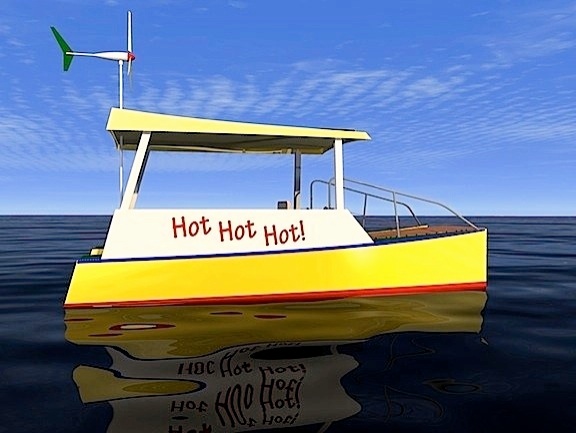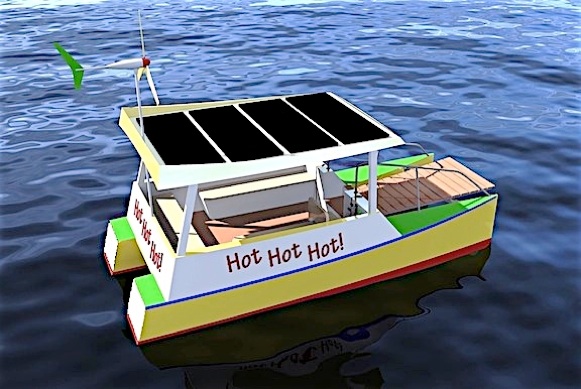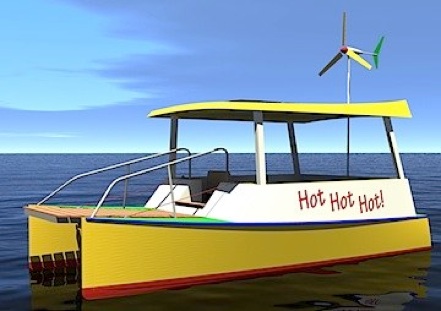
Copyright 2001-2021 inclusive McGowan Marine Design, Inc.
Hot Hot Hot!
a cool water taxi for combatting global warming
Hot Hot Hot! came about when I was asked to come up with a design for a solar/electric water taxi for a small Caribbean island. The requirements were for a boat, or fleet of boats that could take 5-8 people from a dock then land them on a beach, or take them out diving over a reef. It had to have solar panels for low operating costs and a zero carbon footprint. It also had to be robust, and a bit funky (colourful) as that’s what the present outboard-powered ones are.
The hull design is based on a 65’ catamaran that was tank tested very well, and showed to be especially good in speed ranges below a S/L ratio of 1.5. (that is, up to 1.5 x the theoretical hullspeed, or pre-planing range).
Hot Hot Hot! Movie
Construction is stitch-and-glue plywood with fibreglass sheathing for toughness. The narrow flat bottom is good for beaching, and the upper hull shape has a nice chine flat, with the lower ‘canoe’ hull for battery storage and drive motor/shaft setup. The shaft is horizontal and with a dripless seal, and the prop is shrouded by a Kitchen Rudder - providing greater control, and diver protection.
There are three ‘levers’ for operating the boat: a joggle stick for steering (beside the helm), a rudder actuator (for opening and closing the Kitchen Rudder - located in front of the helmsman), and the throttle (a simple rheostat lever as only ‘on’ and ‘forward’ are needed with the Kitchen Rudder). Rather than using a threaded rod-controlled actuator at the rudder post head - as in the typical Kitchen Rudder - for simplicity and greater control I’ve opted for a straight levered linkage, with hydraulics between the top of the rudder post and the shifter at the helm. Like changing gears in a car - the shifter at the helm would have slots at predetermined places for different settings at the rudder: fully open, partially closed for crabbing side-ways (maybe two settings) and fully closed.
At first, I looked at electric outboards but couldn’t find any that could handle full-time work in salt water. Then I remembered the interesting asymmetric catamarans (proas, really) that Aspen Power Catamarans makes, and gladly adopted a single-drive system - but without the proa hull setup as the speeds needed to be less than 6 knots: that is, never needing to plane. As anyone who’s moved a catamaran around with a single outboard at slower speeds knows, you really don’t notice if the motor is off-centre. The true catamaran hull configuration simplifies construction and maximizes load-carrying ability and flexibility.


LOA
Beam
Draft
1/2 Load Displacement
Motor Size
Panels
Wind Generator
18’1”
8’-5”
1’-3”
2000 lbs
6-9 kW 48v
4 x 245W
400 W
5.51
2.57m
0.38m
0.91t
Specifications
Solar charging in the tropics is an easy choice, and the small wind generator would allow for charging day or night - as long as the wind is blowing: perfect for overnight charging after a long day of motoring.
This could make a an amazing little cruiser! Imagine glass all-around, a Queen-sized folding couch aft, full headroom in hulls: with head to starboard (aft), galley to port (fwd), a bench seat helm and controls in the centre (with sitting headroom), and a sliding door in the centre of each side. Access forward through a large opening window, with windscreens tilting forward - trawler-style. Very cool, efficient, and fast!
Designed with TouchCad

